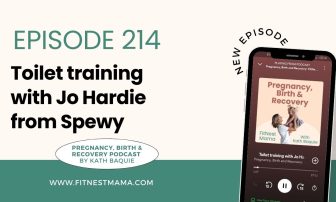Please note that this transcription was completed with computer voice recognition software. Quite often unanticipated grammatical, syntax, homophones, and other interpretive errors are inadvertently transcribed by the computer software. Please disregard these errors. Please excuse any errors that have escaped final proofreading.
If you are pregnant or you’ve recently had a baby, this podcast is for you. I am your host, Kath Baquie. A physiotherapist working in women’s health and a mum of three. Join me each week as we dive into all things pregnancy care, childbirth and postnatal recovery. Helping you have a wonderful pregnancy and after birth experience. And don’t forget to hit subscribe so you don’t miss any episodes.
Well, hello there! It’s great to have you here for another episode of the FitNest Mama Podcast. So, today’s episode is a question that was actually sent through to me via Instagram. So, thank you, Rebecca, who sent me a DM asking, “How do I relax tight pelvic floor muscles and what are some things I should be thinking of?” So, it’s a great topic because it’s actually a really common issue. I think we’ve gone through this bit of an evolution in terms of pelvic floor where years and years ago, no one talked about them at all. We didn’t really know anything about them, then we started to recognize the value of strengthening weak pelvic floor muscles.
So, we all talked about pelvic floor exercises and strengthening. And now thanks to research and, and learning more, knowing more, we’re actually discovering that it’s not just a matter of having a weak pelvic floor. And there’s actually quite a lot of women who have what we call overactive pelvic floor muscles, or tight pelvic floor muscles and those situations where, where we need to, we need to be able to relax them. So overall, to have functioning healthy muscles, it’s like any muscle in the body, we want them to be strong, we want them to be relaxed. It’s just like our bicep muscles, or our neck muscles. If our neck muscles were turned on and activated and tight, we would probably start to develop head neck pain. So, we want our muscles to be functioning properly.
So, today’s episode, we’re going to discuss, what are we talking about when we are talking about tight pelvic floor muscles? Why do we need to know about this? So, ladies, listen up, because if you’re pregnant, if you’ve if you’re not even pregnant yet, or you’ve had your baby or a caesarean birth, or you’re further down the track, this episode might be relevant for you. We’re going to discuss when to relax or when we need to be focusing on this relaxation side of pelvic floor muscles. And also, we’re going to go into the “how”, the practical side.
So, let’s dive in. But before we do dive in, I would just love to invite you to join us inside FitNest Mama. So, reclaiming your pelvic floor core and strength safely is the most effective way to care for your body constantly during and after pregnancy. And all of this is available with FitNest Mama. So, if you have found you’re not exercising as much as you’d like to during pregnancy or after birth, perhaps you’re busy or you’ve lost motivation, or you’re not sure how to be best looking after your body. Perhaps you’ve got pelvic girdle pain or abdominal muscle separation, and you’re not sure about the best exercises for you. Or you’d like to get back into running after birth and you want the best kickstart possible, then FitNest Mama is for you. So, join us for these convenient short, easy workouts that you can do from home whilst your bubba sleeps, your toddler runs around, or at the end of a long day at work. So just simply head to my website fitnestmama.com and the link is in the show notes. Alright, let’s dive into this episode.
Okay, so like I said at the start, our pelvic floor muscles is part of our core, it’s a part of our pelvis. And it’s one element that we want to be functioning well for so many different reasons. Just like our head and neck muscles. We don’t want these muscles tight all the time, we might get head neck pain, discomfort, stiffness, so why do these muscles need to relax? So, let’s just first off start off by saying all muscles in the body need to relax. We all have muscles that need to activate at times and then relax at time so muscles might be weaker after having a baby or sometimes they’re overactive and sometimes you can actually have overactive and weak pelvic floor muscles. So why is this an issue? Okay, so if you’ve got any issues with sexual pain, so pain during intercourse, difficulty emptying the bladder or bowel, so constipation or perhaps you’ve got coccyx pain or back pain. These are some red flags, I guess something that might indicate pelvic floor muscle over activity. And it would be worth touching base with the health care provider.
And I do actually have a free checklist. Check the show notes. It’s at fitnestmama.com/checklist. So, it’s a really simple yes, no questions. And if you answer yes to any of these questions, I do highly encourage you to go and seek that assessment from your local pelvic floor physio. But it might also be that some other I guess, populations within our society that have higher levels of activity in the pelvic floor muscles might be athletes, or people that do a lot of exercise. Or it might be people who are, perhaps have some anxiety or high stress levels. And you can understand that because if it like we all get stressed at times, and I know personally, when I’m stressed, I definitely feel I’ve got tension in my forehead, and I start to frown, but also in my head or neck. And I know some people suffer migraines, so we all hold tension in our body at times, some of us might be more prone to holding out tension in our upper body. But some of us might be more prone to holding our stress levels and our tension in our tummy muscles and grip with our tummy muscles. So having said all that, though, sometimes we can’t identify like someone will come and see me in the clinic. And there’s no clear reasons why someone might have overactive pelvic floor, like, there’s not necessarily a reason or there’s no known cause.
So, when do we want to relax these muscles? We want to relax these muscles when we’re opening our bowels like we don’t want them to be overactive during sex. We don’t want them to be overactive during the day so that it causes any pain like coccyx pain or back pain. But importantly, as well, if you are pregnant, being able to relax your pelvic floor is super important for the preparation of childbirth. If we think about birth, a vaginal birth, as in a baby coming through your womb, we want those doors, so, if we think about the pelvic floor region as doors, we want those doors to be open, we don’t want those doors to be closed. So, we don’t want the pelvic floor muscles to be zipped up and close together. And I know this is a podcast and it’s very much a visual thing. So, I might have to start to put these podcasts on YouTube, it’s been on my to do list, but that visual might help. So, if you’re a bit confused what I’m talking about, come and join us inside FitNest Mama. Because I’ve got lots of videos demonstrating this.
So, for birth, we want these doors to open, we want the baby, like everything to loosen up so the baby can come through the birth canal. And I’m saying this all very simplistically. But if we’ve got overactive pelvic floor muscles, it’s like almost the doors are shut. So pelvic floor relaxation can be one really important element for preparation childbirth, and I believe pelvic floor relaxation goes really well hand in hand with other techniques that you might use to prepare for birth. Whether or not that’s hypnobirthing, calm, birthing, affirmations breathing strategies, they’re all different ways to help your body relax. And that would include your pelvic floor.
Now, relaxing your pelvic floor muscles can also work really well perineal massage. So, if you can’t relax the pelvic floor completing perineal massage, it’s sort of like trying to open a locked door, we want the doors to open and we want to encourage those doors to open wide. So, if we’re doing perineal massage, and I have got a previous episode on this, if you would like me to dive into this more, this alone could be a whole pelvic floor episode. But if we are doing perineal massage, it really helps to do that in conjunction with pelvic floor relaxation. And it might actually be really helpful if you do have overactive pelvic floor. And then also after a caesarean birth, for hormonal reasons for multiple reasons, or after vaginal, but I do see it more often in my mums’ who’ve had a caesarean birth, there might be issues with pelvic floor over activity. So, there are the key times in our life when we want to be aware of this and as I said, if there’s any red flags or anything that’s listening to this episode, you’re thinking oh, that’s me. Do just go and have a chat to your local pelvic floor physio.
Okay, let’s go through how to relax the pelvic floor muscles, the practical side of things. So, we’ve talked about the “what”, the “why”, and the “when”, I guess. And now let’s talk about the “how”. So how do we relax muscles if you’re thinking of “Yeah. I recon I do have overactive pelvic floor.” There are a few things that we can think of. First of all, let’s get in tune with diaphragmatic breathing. So, popping your hands on the bottom of your rib, your ribcage and as you breathe in, feel your ribcage expand. And then as you breathe out, feel your ribcage floor. So beautiful deep breaths that involves the lower part of your ribcage. Visualizations can help. So, imagine ripples in the water. Or another, stay with me here, if you are standing above a pond and you drop a pebble into the pond, you know how the ripples come out. So that can be a really nice way to think about relaxing your pelvic floor. Or if you think about a flower bud that’s blooming, so you think about the blooming of a flower and that flower is your pelvic floor so that opening up, they can be some nice visualizations. Whole body relaxation can work wonders, abdominal relaxation, so letting your tummy drop and flop. Often if we’re gripping and holding in our tummy muscles, then you might be holding in your pelvic floor at the same time. So really letting your tummy drop and flop. I love to encourage a body scan. So, this might be a 10 second or five second body scan you start from head to toe. So, let’s all do it. Now find yourself in a comfortable position. If you can, even if it’s standing, that’s fine. Take your focus to your forehead and letting any muscle tension in your forehead. Melt away. And your jaw is letting your jaws soften and open. Letting your mouth open. Letting your neck and shoulders, release. Nice soft arms, beautiful soft breathing, letting your tummy drop and flop, letting your pelvic floor, release. Filling your glutes and your bottom muscles in your thighs soften and melt away and down to your feet. And your carbs and letting your toes soften, curl relaxed.
So that’s a quick body scan, it really didn’t take that long at all. And you just going from head to toe. And you’ll you might notice the more you do this, you might notice that you hold muscle tension in certain parts of your body. So, for me, I know I hold it in my forehead and my jaws. And so, once you’re aware of this, then we can work with it. Also, with this relaxation of the pelvic floor, we want to do this in a calm and relaxed environment. There’s no point in trying it when the kids are having a tantrum or your baby’s really upset. Or you’re really stressed with work like wait until there’s a bit more of a relaxed, quiet, calm environment for you to try this. And the other place that we can try it on a regular occasion is when we’re opening our bowels and we’re doing your way. We want everything to be relaxed. We should never feel like we’re pushing or straining when we’re opening our bowels. We’re relaxing all those muscles and just letting nature have its course.
So, to finish off with, we’ve talked about all what overactive pelvic floor muscles are. We’ve talked about why they’re important to recognize and treat. We’ve talked about when is a good time to do this. So, in the lead up to pregnancy, pregnancy, and recovery as well. And we’ve talked about how to relax out overactive pelvic floor. So, download, be sure to download the Pelvic Health Checklist that I talked about. The simple yes no answers that will literally take two minutes to complete. So that’s fitnestmama.com/checklist. And also join us inside FitNest Mama if you’d like to support for your pelvic floor, your pregnancy exercise, preparing your body for birth and recovering after birth. We include a lot of pelvic floor information. At the end of every single workout. We’ve got a combination of strengthening and relaxation. And there’s also a 12 week return to running program if you’re postpartum. So, there’s lots there to really help support your pelvic floor and core with birth beyond recovery, life, and everything we need. So, we’d love to see you inside FitNest Mama. So that’s it, ladies. Thank you for joining me today. Do send me a DM on Instagram. I’d love to hear from you. If you’ve got a question that you would like me to cover inside FitNest Mama or if you’ve just got a question, full stop, come and send me a DM. I’d love to hear from you. I’m @fitnestmama on Instagram.
Thanks for listening to the FitNest Mama Podcast brought to you by the FitNest Mama Freebies found at www.fitnestmama.com/free. So please take a few seconds to leave a review, subscribe so you don’t miss an episode. And be sure to take a screenshot of this podcast, upload it to your social media and tag me, @fitnestmama so I can give you a shout out too. Until next time. Remember, an active pregnancy, confident childbirth, and strong postnatal recovery is something that you deserve. Remember our disclaimer, materials and contents in this podcast are intended as general information only and shouldn’t substitute any medical advice, diagnosis, or treatment. I’ll see you soon!





